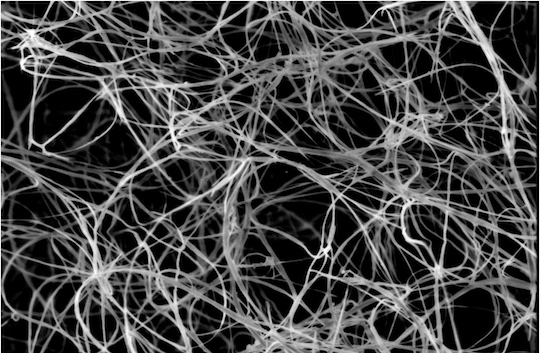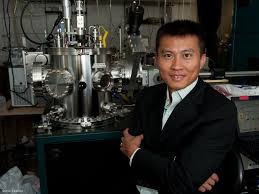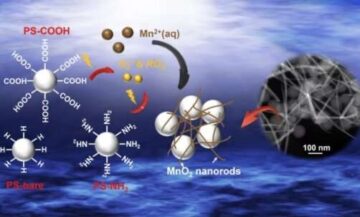
Researchers at Rice University, under the guidance of Professor Angel Martí, have made a significant breakthrough in the field of material science by developing a novel method to create high-purity boron nitride nanotubes.
These nanotubes, cylindrical in shape and hollow, boast remarkable properties such as the ability to endure temperatures up to 900°C (approximately 1,652°F) and surpassing steel in strength-to-weight ratio. This discovery has the potential to revolutionize various industries, including spacecraft manufacturing, biomedical imaging, and hydrogen storage applications.
Led by doctoral student Kevin Shumard and recently published in Chemistry of Materials, details the process of eliminating persistent impurities from boron nitride nanotubes. This purification is achieved using phosphoric acid, coupled with precise adjustments to the reaction process.
Shumard, elaborating on the importance of this development, states, “The challenge is that during the synthesis of the material, in addition to tubes, we end up with a lot of extra stuff. As scientists, we want to work with the purest material we can so that we limit variables as we experiment. This work gets us one step closer to making materials with a potential to revamp whole industries when used as additives to metals or ceramic composites to make those even stronger.”
The impurities in question are boron nitride cages, sphere-shaped structures that encase boron particles, typically degrading the quality and functionality of the nanotubes. This issue led the Rice researchers to explore the use of phosphoric acid, inspired by a 2013 study in the Journal of the American Chemical Society that identified the acid as a boron nitride wetting agent. Professor Martí shared his initial expectations, saying, “We didn’t expect a reaction.” However, the team observed an unexpected outcome when the mixture was heated, leading to the discovery of pyramids instead of tubes and cages.
Realizing that high temperatures and acid concentrations were detrimental to boron nitride, the team revised their approach. They sought to fine-tune the reaction to eliminate only the undesirable structures. This led to a novel purification method for nanotubes, which Shumard describes as a significant step forward, noting, “The material that we can make is by far the purest tubes that I have seen when compared to others.”
The team’s future goal is to enhance the yield of this reaction to produce sufficient quantities of nanotubes for creating fibers. These fibers could potentially serve as a more sustainable alternative to steel, contributing to the development of superior building materials. Shumard emphasizes the sustainability aspect, stating, “Nitrogen makes up 70% of our atmosphere, and boron is highly abundant in rocks. This work could be a stepping stone to much better building materials both in terms of strength and in terms of sustainability.”
Boron nitride nanotubes share similarities with carbon nanotubes in structure and properties such as tensile strength and thermal conductivity. However, they offer greater resilience, and their properties are often complementary to those of carbon nanotubes. While carbon nanotubes can function as electrical conductors or semiconductors, boron nitride nanotubes are insulators.
Martí highlights the potential of this research, stating, “The science on boron nitride nanotubes is not as well developed as the science on carbon nanotubes—a gap we were hoping to address in our research because we think the ability to produce pure boron nitride nanotubes efficiently and reliably could be important for a wide range of industries.”
This innovative achievement by the Rice University researchers not only paves the way for stronger, more heat-resistant materials but also exemplifies the power of scientific inquiry and experimentation in overcoming challenges and advancing technology. Their work stands as a beacon of progress in material science, potentially ushering in a new era of sustainable and high-performance materials that could fundamentally transform a multitude of industries.
- SEO Powered Content & PR Distribution. Get Amplified Today.
- PlatoData.Network Vertical Generative Ai. Empower Yourself. Access Here.
- PlatoAiStream. Web3 Intelligence. Knowledge Amplified. Access Here.
- PlatoESG. Carbon, CleanTech, Energy, Environment, Solar, Waste Management. Access Here.
- PlatoHealth. Biotech and Clinical Trials Intelligence. Access Here.
- Source: https://genesisnanotech.wordpress.com/2024/01/26/rice-universitys-pioneering-research-in-boron-nitride-nanotubes-potential-to-fundamentally-transform-a-multitude-of-industries-hydrogen-storage-and-spacecraft-manufacturing-among-them/
- :has
- :is
- :not
- $UP
- 1
- 2013
- a
- ability
- abundant
- achieved
- achievement
- addition
- additives
- address
- adjustments
- advancing
- Agent
- also
- alternative
- American
- among
- an
- and
- Angel
- applications
- approach
- approximately
- ARE
- AS
- aspect
- At
- Atmosphere
- BE
- beacon
- because
- Better
- biomedical
- both
- breakthrough
- Building
- Building Materials
- but
- by
- cages
- CAN
- carbon
- carbon nanotubes
- challenge
- challenges
- chemical
- chemistry
- closer
- compared
- complementary
- conductivity
- contributing
- could
- coupled
- create
- Creating
- describes
- details
- detrimental
- developed
- developing
- Development
- discovery
- Display
- during
- efficiently
- eliminate
- eliminating
- emphasizes
- end
- enhance
- Era
- Even
- exemplifies
- expect
- expectations
- experiment
- explore
- extra
- far
- fibers
- field
- Files
- For
- Forward
- from
- function
- functionality
- fundamentally
- future
- gap
- goal
- greater
- guidance
- Have
- High
- high-performance
- highlights
- highly
- his
- hoping
- However
- HTTPS
- hydrogen
- i
- identified
- Imaging
- importance
- important
- in
- Including
- industries
- initial
- innovative
- inquiry
- inspired
- instead
- issue
- journal
- jpg
- leading
- Led
- LIMIT
- Lot
- made
- make
- MAKES
- Making
- manufacturing
- material
- materials
- max-width
- Metals
- method
- mixture
- more
- much
- multitude
- New
- None
- noting
- novel
- observed
- of
- offer
- often
- on
- ONE
- only
- or
- Others
- our
- Outcome
- overcoming
- paves
- Pioneering
- plato
- Plato Data Intelligence
- PlatoData
- potential
- potentially
- power
- precise
- process
- produce
- Professor
- Progress
- properties
- quality
- question
- range
- ratio
- reaction
- recently
- remarkable
- research
- researchers
- resilience
- revolutionize
- Rice
- saying
- Science
- scientific
- scientists
- seen
- Semiconductors
- serve
- Shape
- Share
- shared
- significant
- similarities
- So
- Society
- sought
- spacecraft
- stands
- States
- stating
- steel
- Step
- stepping
- STONE
- storage
- strength
- stronger
- structure
- structures
- Student
- Study
- such
- sufficient
- superior
- surpassing
- Sustainability
- sustainable
- synthesis
- team
- Technology
- terms
- that
- The
- their
- Them
- thermal
- These
- they
- Think
- this
- those
- to
- Transform
- typically
- under
- Unexpected
- university
- us
- use
- used
- ushering
- using
- variables
- various
- want
- was
- Way..
- we
- WELL
- were
- when
- which
- while
- whole
- wide
- Wide range
- with
- WordPress
- Work
- Yield
- zephyrnet









